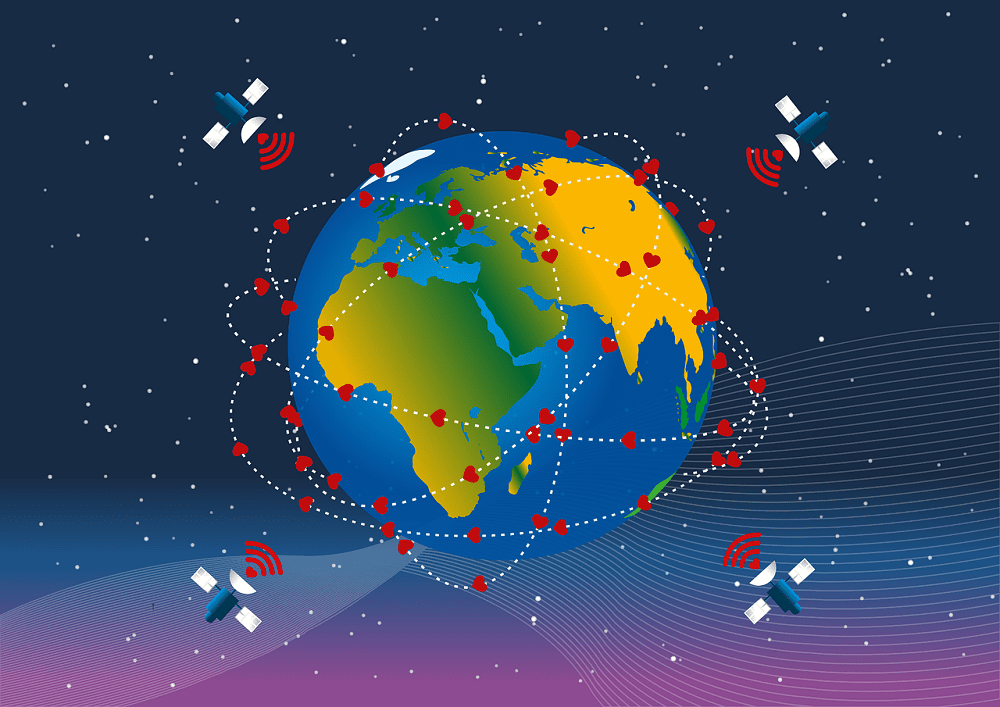How does the Internet by means of Satellite functions?
Satellites have brought Internet access to places where IP communication appeared to be outlandish. It has provided everyone with the facility of the internet in the far flung corners of the world.
In this blog, we will explain how satellite Internet works. You will see how bytes of data or just a mouse click moves right from your PC to the satellite, to the NOC (Network Operations Control) and back.
Commercial satellite connections are used in VSAT systems (Very small aperture terminal) as a fast-speed internet connection between the users and the Internet backbone. A satellite system consistent of following parts:
1. GROUND-BASED ELECTRONIC EQUIPMENT
- The VSAT dish: It hints at what the vast majority call their dish. VSAT units are two-way satellite ground stations with dishes that ordinarily go from 0.98m to 1.8m in width. VSAT Systems offers VSAT reception apparatuses somewhere in the range of 1.2m and 2.4m in breadth, contingent upon the application and area.
- The indoor modem: A satellite modem enables data to transfer through a correspondence satellite as a hand-off. VSAT Systems end clients normally utilize the iDirect, Evolution, X3/X5 modems.
- The Teleport: The satellite teleport is the earth station that controls data transmission over the space connections. The teleport is the core of the VSAT Systems satellite Internet framework. VSAT Systems has three 6.3m Vertex RSI antennas, one 8.1m VertexRSI reception apparatus, transmitters, and control networks, repetitive connections to the Internet, additional power and HVAC i.e. heating, ventilation and air conditioning.
- The Network Operations Center (NOC): It is an amenity which controls all data transmission and communications over the satellite connection. The NOC screens for power shortage, signal issues of satellites and other issues that may fluctuate the system. The VSAT Systems NOC is situated in different areas all over the USA.
Find a secure high-speed internet connection in your area with the Best Cable World services. Enter your ZIP code to find out.
2. SATELLITE EQUIPMENT
- The Satellite: In a geostationary or geosynchronous orbit 22,236 miles over the world’s surface, a satellite finishes one upheaval in the very same measure of time that it takes the Earth to complete one full turn on its axis. Subsequently, the satellite consistently shows up at a similar situation over the Earth. This wipes out the requirement for satellite dishes at the client area to follow the satellite, which effectively streamlines development and cost. These satellites, utilized for an assortment of purposes like telecommunications and broadcast, can likewise be utilized to give Internet access at any area on Earth.
Get the best satellite internet connection and top TV providers by ZIP code all across the US by Cable World. Enjoy high-speed internet and 200+ HD channels with Cable World.
- Transponder Space Portion: The communication stations on a satellite that both get and retransmit information. Latest satellites convey around the range of 36 and 72 separate transponders all running at various frequencies. These segments are used for transmission of information or data.
- Internet Backbone: The backbone is a huge assortment of interconnected, high-limit, business, government, and scholastic information paths and center routers that transports information. They link with different nations and continents across the globe.
HOW THE PROCESS WORKS:
Here we have described how the process of satellite internet works. The process consists of five easy steps.
- Computer of the end user is connected with the system, which thus is connected with the Internet by VSAT Systems. You open an internet browser and type in a web address. The end user computer sends a request for an exchange of information, for both transmittal and receiving.
- The request sent from the end user computer is transferred through their home system, to the indoor satellite modem which then modifies the incoming signals and passes it to the VSAT dish. The VSAT dish changes over these signals to RF (radio frequency) signals and sends it to a satellite situated in the geostationary orbit at the speed of light which is 186,000 miles per second.
- The satellite in the geostationary orbit gets this signal and transfers it to one of the VSAT system teleport hubs situated in respective locations. This shows that despite the fact that the bundles of data travel huge distances from one corner to another by means of the space segments, the bundles bounce less systems because of the huge decrease in the quantity of inter domain and intra domain routers providing a chance to slash latency.
- Now the request at this point goes to VSAT Systems NOC, which recovers the mentioned site from the internet server, over the US Internet backbone.
- The entire cycle is then turned around and the requested information or data is accessible to the client via big data journey, through an infrastructure setup with millions of dollars and complex equipment, all in under jiffy.

As the editor of the blog, She curate insightful content that sparks curiosity and fosters learning. With a passion for storytelling and a keen eye for detail, she strive to bring diverse perspectives and engaging narratives to readers, ensuring every piece informs, inspires, and enriches.










